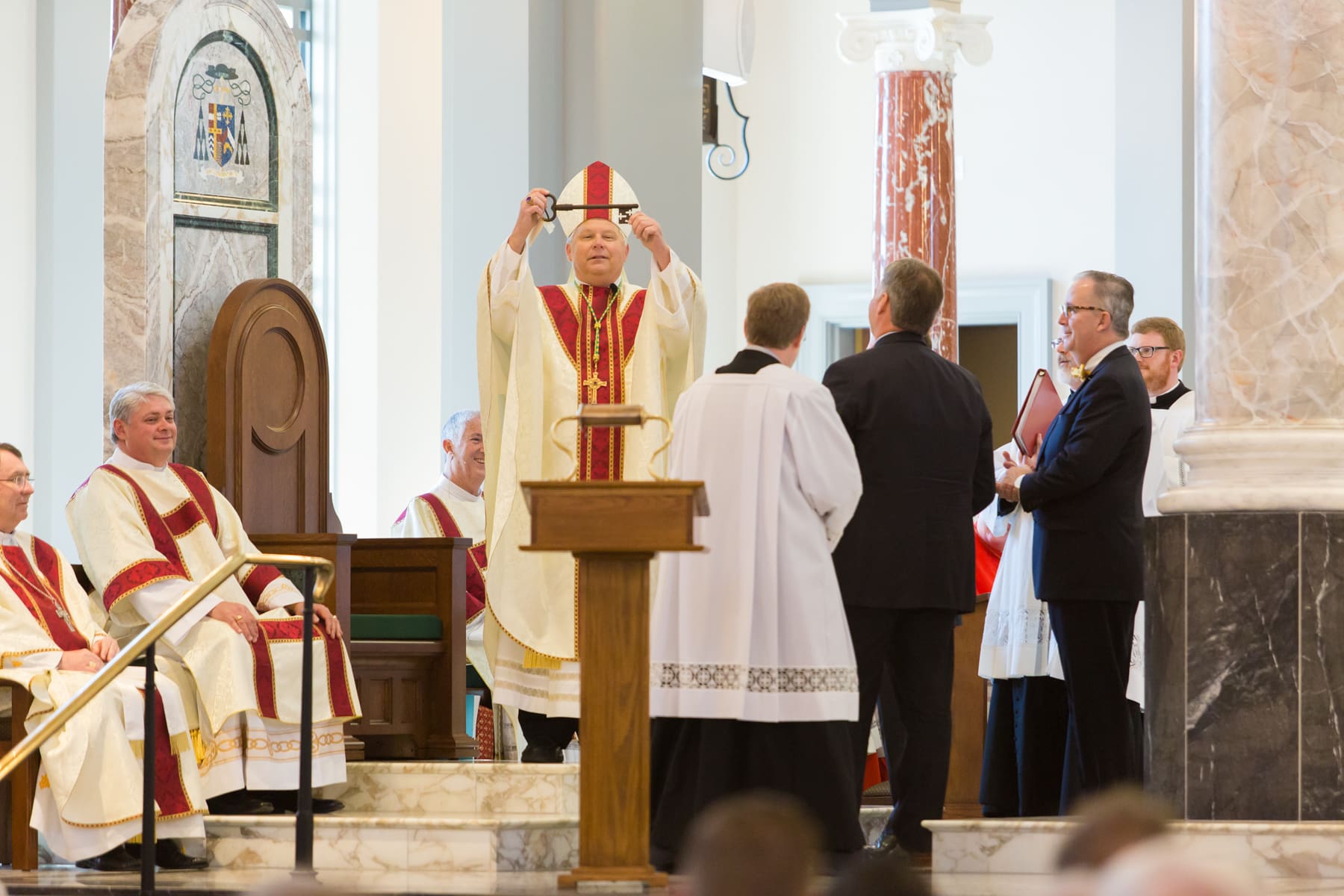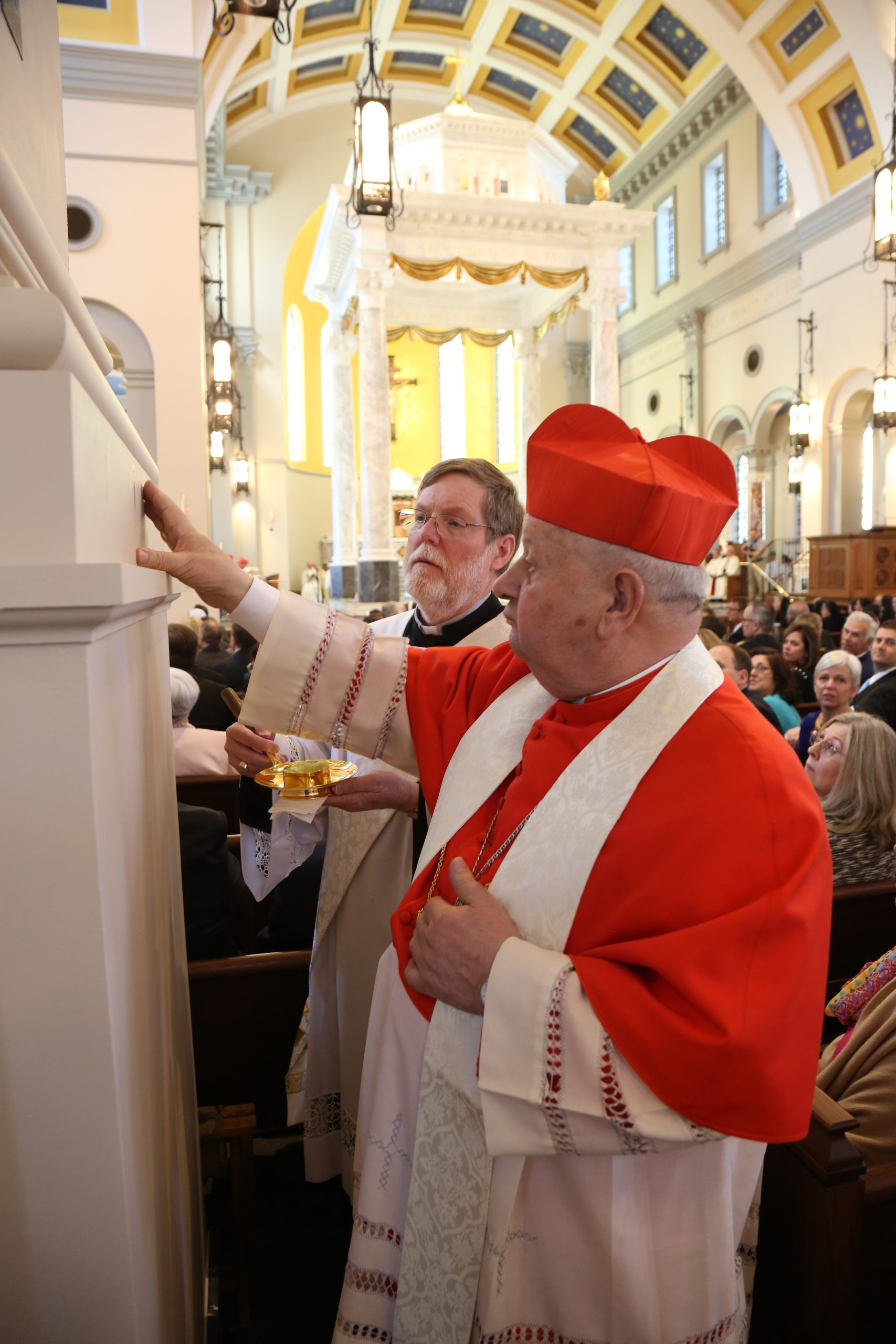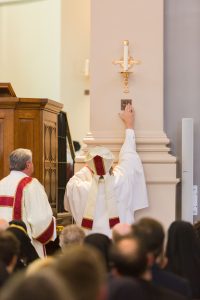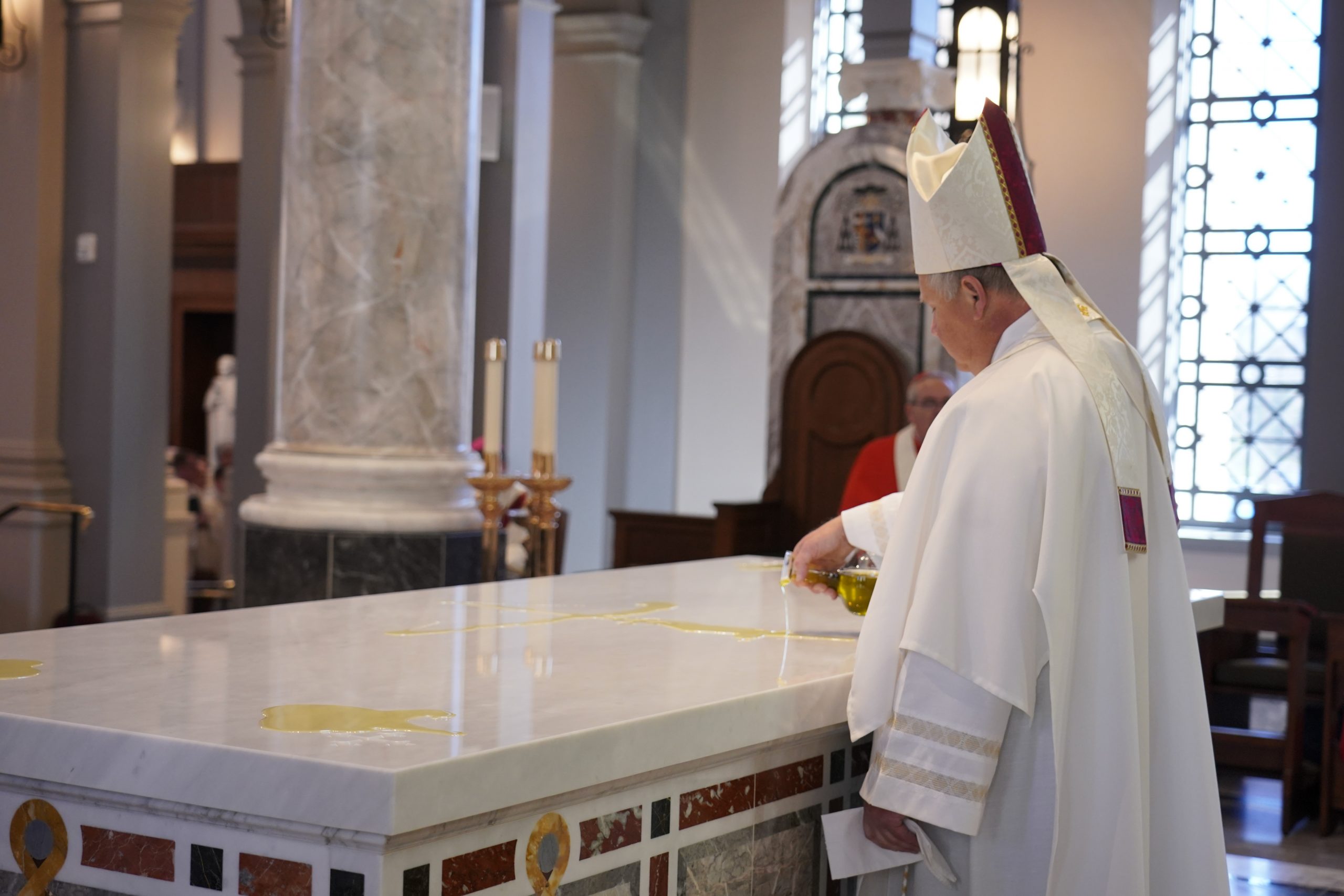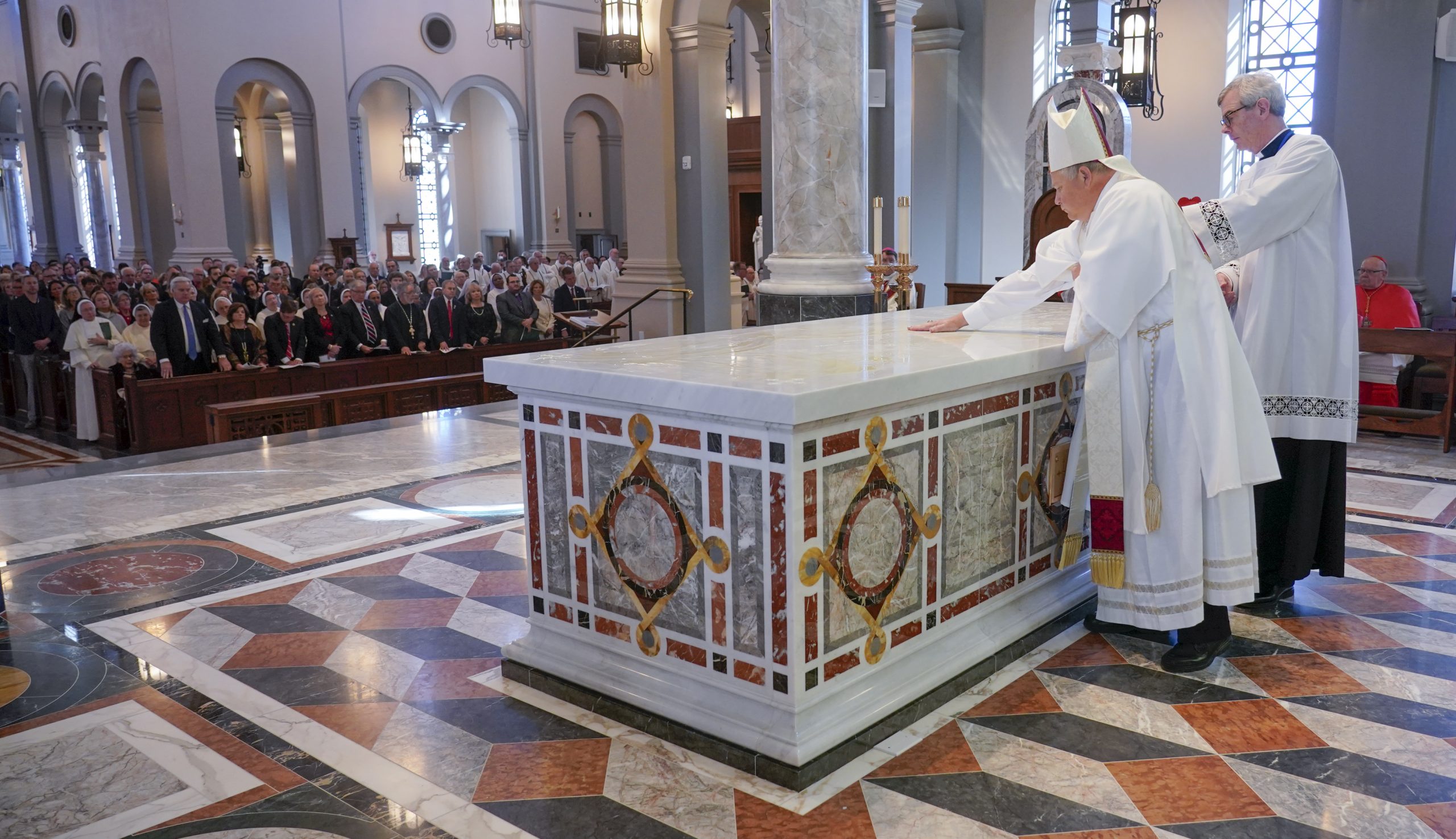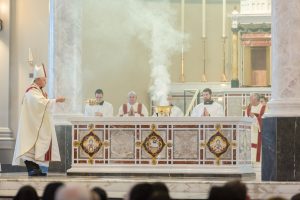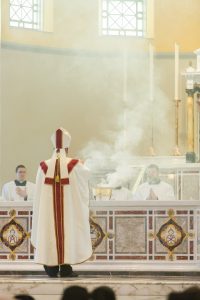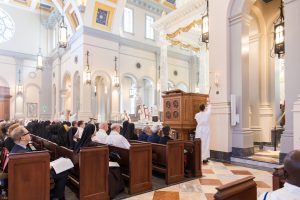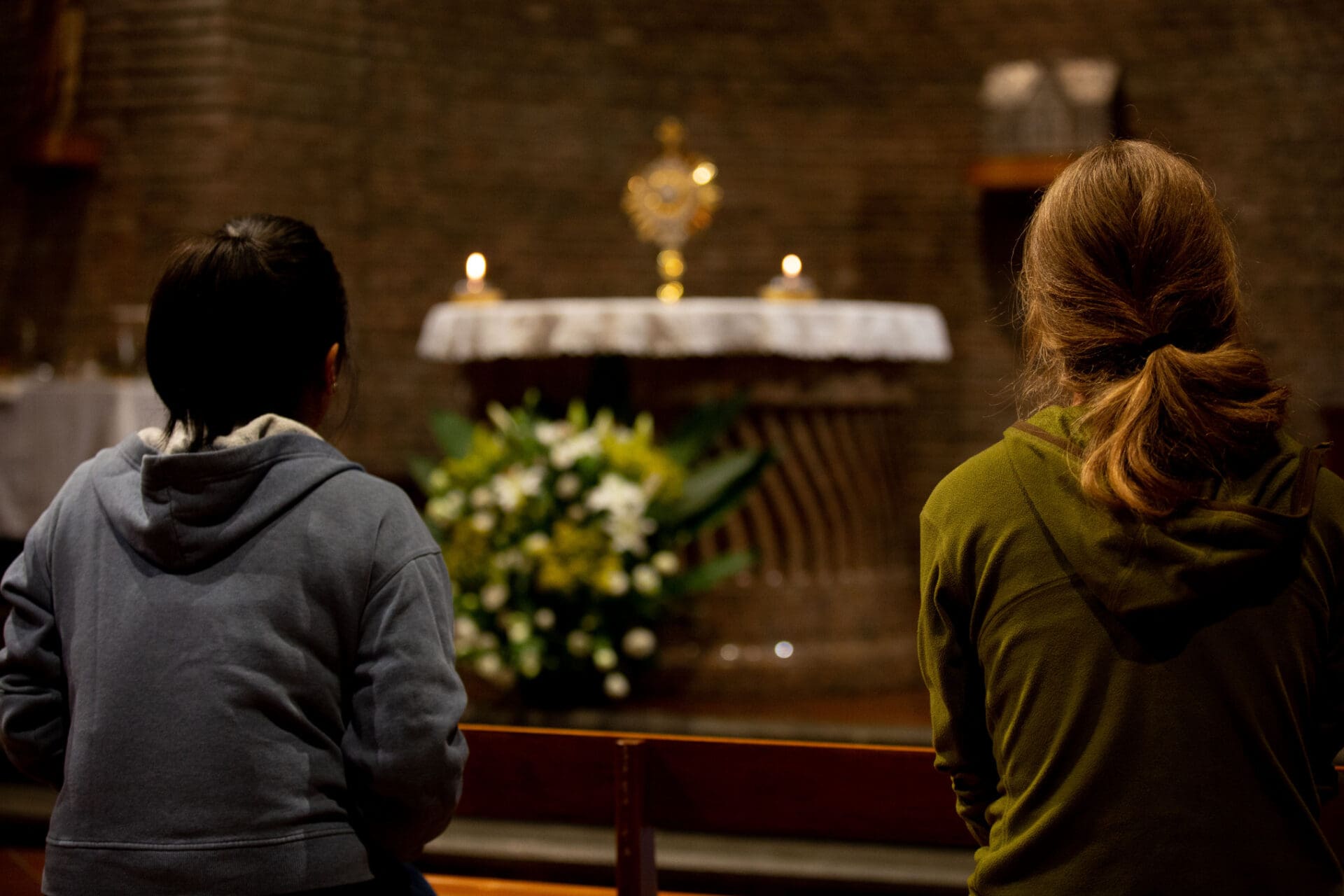There are few events in the life of a parish community more important or more festive than the dedication of a newly-constructed church building. Typically, this defining moment is the culmination of a long process—often lasting years—of discernment, planning, fund raising, and building on the part of the parish membership and its leaders. As is the case with many other seminal moments in the lives of the church community and its individual members, the Church provides a significant liturgical celebration to mark the dedication of a new church, known formally today as The Order of the Dedication of a Church and an Altar.
“Beloved brothers and sisters,” begins the bishop’s announcement before entering the new church, “we have gathered with joy to dedicate a new church by celebrating the Lord’s sacrifice. Let us take part in these sacred rites with loving devotion, listening to the Word of God with faith, so that our community, reborn from the one font of Baptism and nourished at the same table, may grow to a spiritual temple and, brought together at one altar, may advance in the love from on high” (The Order of the Dedication of a Church, 30).
With these words usually spoken outside the building, the presiding bishop summarizes what is about to take place. This suggested but optional text encapsulates the main elements of church dedication as well as its theological underpinning: the Mass itself is the principle act leading to the dedication of the church building; the reading of Sacred Scripture will be prominent; the whole community of the faithful have a role to play in what is about to take place; the sacrament of Baptism, the Eucharist, and other sacraments and sacred rites which will henceforth be celebrated in this new church and upon its altar will form and define the Christian community which gathers within.
Importantly, as even this brief introductory text makes clear, it is ultimately the faithful who are being transformed into the Church’s “living stones” (1 Peter 2:4-5, “Come to him, a living stone, rejected by human beings but chosen and precious in the sight of God, and, like living stones, let yourselves be built into a spiritual house to be a holy priesthood to offer spiritual sacrifices acceptable to God through Jesus Christ.”). These solemn and festive rites serve to remind the faithful that they themselves form the Church, with Christ as its head, and that the new church building being dedicated will play a vital part in this endeavor.
On May 21, 2018, the President of the United States Conference of Catholic Bishops, Cardinal Daniel DiNardo, Archbishop of Galveston-Houston, issued a formal Decree of Publication for a revised translation of this ritual text. This decree allows for the publication of this newly-revised text, and stipulates that this is the officially approved text. This new English text is presently available from USCCB Communications and its use is mandatory beginning November 9, 2018—appropriately, on the Feast of the Dedication of the Lateran Basilica. The purpose of this article is to explore what has and has not changed with this new translation, and to introduce some of the distinctive features of this important rite.
Text in Context
Interestingly, this new text is the first official English translation of the Latin typical edition of the 1977 Ordo Dedicationis Ecclesiæ et Altaris permanently approved for use in the dioceses of the United States. The English translation which had been in use since 1978 was approved ad interim by the Holy See, apparently with the expectation that a final version would be submitted for permanent approval within a few years. For reasons not entirely clear, a final text was not submitted to the Holy See until this revised translation was canonically approved by the US bishops in November 2014 and submitted to the Congregation for Divine Worship and the Discipline of the Sacraments for its necessary confirmation. The confirmatio was finally granted on November 9, 2017.
Both the old and new versions are contrasting translations of the same Latin typical edition promulgated by the Holy See in 1977. It has undergone no changes or adaptations to the rite itself for the dioceses of the U.S.A. Only the translation itself has been modified to be in conformity with the 2001 instruction Liturgiam Authenticam, and texts derived from the Missal are in complete continuity with Roman Missal, 3rd Edition of 2011. Given the preference for a more literal treatment of the original Latin texts called for in Liturgiam Authenticam, a few of the new English texts depart noticeably from those which have been in use since 1978. A portion of the important Dedicatory Prayer (n. 62 in The Order of the Dedication of a Church) intoned or said by the presiding bishop will serve to illustrate the transformation:
1978 Provisional text:
Father in heaven,
source of holiness and true purpose,
it is right that we praise and glorify your name.
For today we come before you
to dedicate to your lasting service
this house of prayer, this temple of worship,
this home in which we are nourished by your word and your sacraments.
New 2018 text:
O God, sanctifier and ruler of your Church,
it is right for us to celebrate your name
in joyful proclamation;
for today your faithful people desire
to dedicate to you,
solemnly and for all time,
this house of prayer,
where they worship you devoutly,
are instructed by the word,
and are nourished by the Sacraments.
One internal feature which has undergone significant improvement in the newly revised ordo is the careful setting of numerous antiphons, Psalm texts, dedicatory prayers, and dialogues in chant notation. The musical settings of these various elements are based on the original musical settings of the Latin text provided in the typical edition. Although considerable reworking of the original melodies is required to translate from Latin text to English text, nonetheless the settings provided in the new English translation bear a close kinship to the Latin originals. While the use of these settings is not mandatory, their quality and their convenient presence in the ritual text itself should provide a new and valuable musical treasury for celebrants, cantors, choirs, and assemblies at future church dedications.
It is also important to note that the Order of the Dedication of a Church and an Altar contains various other rites pertaining to the construction and use of new churches and chapels in addition to the dedication itself. Besides the solemn church dedication, the text also includes the Order of Laying a Foundation Stone (or the Commencement of Work on the Building of a Church), the Order of the Dedication of an Altar alone, as well as rites for the blessing of a church or an altar. Whether a church or altar is dedicated or blessed is a question of permanence. Church buildings and altars are dedicated when they are set aside permanently for use in the celebration of the sacred mysteries. However, sometimes a space can only be set aside temporarily for worship, such as in the case of a school or hospital chapel or other institutional setting which might undergo change in the foreseeable future. These spaces are often blessed rather than dedicated. Additionally, moveable altars may be blessed rather than dedicated. Although the first Mass celebrated in any new church should be the Mass of Dedication, in some situations communities must begin using their new church before it has been solemnly dedicated. In light of this pastoral reality, the text also contains an Order of the Dedication of a Church in which Sacred Celebrations are Already Taking Place.
The dedication of churches or altars is the responsibility of the bishop. He can, however, in exceptional circumstances delegate the privilege to a Priest. While it would be of great interest to compare and contrast all these rites, space allows only an overview of the formal dedication of a church.
Entrée to the Feast
The unique features of the entrance into the new church serve to remind everyone present that they indeed are living stones constituting the Church. The rite itself provides considerable flexibility in the details of how this will unfold in various pastoral situations. If the older church building is still present within a reasonable distance from the new building, the clergy and lay faithful may gather in the old building from which they will process, together with any relics to be placed under the altar, to the closed door of the new church. Such a procession would embody the parish’s respect and veneration for the old church as it now moves on to the new. All are participants, not just by their movement toward the exterior door, but also by the singing of the antiphon or another appropriate hymn.
A procession from the old church to the new, if it is possible, not only frames the beauty and dignity of the created work itself in a liturgical context, but it can also symbolize the spiritual progress and the journey of the local community that is about to enter it. If such a procession is not feasible, then the faithful simply assemble at the doors of the new church. The rite even foresees the possibility that, in some situations, it may not be desirable to gather outside the closed doors of the new church, if for example the church is in a busy urban area with heavy traffic and little room to gather safely, or even if there is inclement weather on the day of the dedication. In this case, the faithful may be seated within the new church.
Once the clergy and the rest of the community have gathered outside the doors of the new church, the bishop greets all present and addresses the people using the text mentioned at the beginning of this article, or words of his own choosing. Then a ceremonial presentation of the new church building to the bishop takes place. As the rubrics indicate (n. 40), this presentation can take a variety of forms:
“Then representatives of those who have been involved in the building of the church (the faithful of the parish or of the diocese, donors, architects, workers) hand over the building to the Bishop, offering him, according to place and circumstances, either the legal documents for possession of the building, or the keys, or the plan of the building, or the book in which the course of the work is described and in which the names of those in charge of it and of the workers are recorded.”
A representative may then address the bishop and the community. The rite provides no set words for this, but instead leaves the details of this moment to the needs and circumstances of individual communities and projects. As a result, no two of these ceremonies at the door will be exactly the same. This early point in the dedication liturgy brings the visible human realities of planning, financing, participation, and work into prominence. When all this has taken place, the pastor, at the bishop’s invitation, opens the door of the new church from the outside, and the bishop invites all to enter. The clergy and lay faithful then enter the new building. No incense is used for this procession, nor are the altar candles lighted.
High Water Mark
Once the procession to the sanctuary has concluded, a vessel of water is brought to the bishop, which he blesses to be sprinkled on the people as a sign of repentance and as a reminder of their Baptism. It is significant that this same water is used to bless both the assembled faithful as well as the walls and altar. This gesture is a further reminder of the close connection of the new building with the people themselves. The people are present to be blessed along with the building.
Once the water has been blessed, the bishop moves through the church sprinkling both walls and people; when he returns to the sanctuary, he sprinkles the altar which has not yet been covered or decorated in any way. Then the celebration continues with the singing of the Gloria and the praying of the Collect.
A Word that Will Rouse Them
Not surprisingly, the inaugural Liturgy of the Word in the new church unfolds in a distinctive way. Two Lectors, one of whom is carrying the Lectionary for Mass, and the minister assigned to intone the Responsorial Psalm approach the bishop. The bishop then takes the Lectionary from the lector, shows it to the people, saying, “May the word of God resound always in this building, to open for you the mystery of Christ and to bring about your salvation in the Church,” to which all reply, “Amen.” The bishop then hands the Lectionary to the first reader, and the lectors and psalmist proceed to the ambo carrying the Lectionary for all to see, where the readings are proclaimed and the Responsorial Psalm is intoned. Curiously, the rite assumes that the Gospel is also proclaimed by a deacon from the same Lectionary, rather than from The Book of the Gospels.
Stone, Oil and Charcoal
Following his homily and the community’s recitation of the Creed, the bishop invites the assembly to join in the Litany of Saints. This, appropriately, is followed by the placement of the relics of a martyr or other saint beneath the altar. Although encouraged, it should be noted that the presence of relics is no longer strictly required. If there are to be relics enshrined, the rubrics even call for a stonemason to be present to seal up the aperture where the relics are placed by the bishop. Once this has been done, the bishop then intones or says the long Prayer of Dedication. This prayer is rich with scriptural imagery and allusions to the Paschal Mystery which will be remembered and celebrated for years to come in this new building and upon the new altar.
The bishop then anoints the bare altar by pouring Holy Chrism both in the middle of the altar and on each of its four corners. The luxurious aroma of chrism usually fills the entire church! Then the walls themselves are anointed at twelve locations, as is the venerable custom, or if circumstances suggest, at only four points. The places where the walls are anointed are marked in perpetuity by crosses and candles mounted on the walls. The anointing of the altar renders the altar itself as a powerful symbol of Christ, which means “Anointed One,” who on the altar of his body offered the sacrifice of his life for the salvation of all. The anointing of the walls of the church with the same chrism is an act of consecration, not unlike the anointing of a priest’s hands at his ordination. The anointing of the church’s walls indicates that it has been set aside permanently for Christian worship.
A brazier for the burning of incense is then placed on the altar. Alternately a heap of incense may be stacked directly onto the surface of the altar. The bishop then adds incense to the hot coals in the brazier, or he lights the heap of incense stacked on the altar itself. While the incense is burning on the altar, the bishop then places incense in a number of thuribles and incenses the altar with one of them. Afterwards, several ministers move throughout the church incensing both the people and the walls. As the rite’s Introduction indicates (n. 16b), the incense burned on the altar actually signifies the sacrifice of Christ “ascending to God as a pleasing fragrance.” It is also a sign of the prayers of the people rising up to the throne of God. “Moreover,” the Instruction continues, “the incensation of the main body of the church indicates that the dedication makes it a house of prayer; but the People of God are incensed first, for they are the living temple in which each faithful member is a spiritual altar.”
Following this very dramatic, memorable, and fragrant moment, the altar is at last dressed with the appropriate coverings, for it has now become the Lord’s table, and it is to be adorned as the table of a sacrificial banquet and adorned as for a festive occasion. Other items necessary for the celebration of Mass, including unlighted candles, are now arranged on or near the altar. Then the bishop directs the altar candles and those throughout the church to be lighted with these words (70): “Let the light of Christ shine brightly in the Church, that all nations may attain the fullness of truth.” This new building and its altar have been blessed with water, dedicated to liturgical service, anointed with Chrism, and further blessed with large amounts of incense. The Word of God has already resounded within its walls for the first time. Now the light of Christ at last illuminates this space, forever set aside as a particular community’s place of worship.
At That First Thanksgiving
From this point, the celebration of the Eucharist enters more familiar territory, except for two noteworthy departures. The first takes place after the deacons have prepared the altar with the gifts of bread and wine and the necessary vessels. Since the undedicated altar was not venerated with the usual kiss following the initial procession into the sanctuary, the bishop now approaches the newly dedicated altar and kisses it for the first time.
The second special element occurs if the Blessed Sacrament is to be reserved in a separate chapel. If this is the case, following the distribution of Communion, the remaining Hosts are placed in a ciborium and left on the altar. After the bishop says or intones the Prayer after Communion, he returns to the altar, kneels, and incenses the Blessed Sacrament. The Blessed Sacrament is then carried in procession through the main body of the church to the chapel of reservation, where the Blessed Sacrament is placed in the tabernacle for the first time.
Now and Forever
This brief article hardly does justice to the luxuriant symbolism, potent prayer, and festive pageantry of the dedication of a church. Some of the most ancient buildings still in use today are churches, so for many, the dedication of a new church might be a once in a lifetime event. How fitting that a building which provides a sacred place for activities which will touch so many lives for years to come should begin its use with such an engaging and festive liturgy.

Photos courtesy of Deacon Patrick Murphy-Racey, Stephanie Richer, Stephen Golder/The East Tennessee Catholic.
